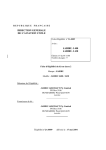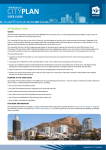Download User Guide for the Proposed Bundaberg Regional Council Planning
Transcript
User Guide for the Proposed Bundaberg Regional Council Planning Scheme Introduction The proposed Bundaberg Regional Council Planning Scheme (the proposed planning scheme) has been prepared under the Sustainable Planning Act 2009 (SPA) to help guide future land use and development in the Bundaberg Region. The proposed planning scheme has been prepared in accordance with the Queensland Planning Provisions (QPP). The QPP are the standard planning scheme provisions made under the SPA that provide a consistent format and structure for planning schemes across the state. The standard suite of zones, overlays, definitions and development assessment rules in the QPP provide the foundation for the proposed planning scheme. The proposed planning scheme has also been prepared to reflect the Wide Bay Burnett Regional Plan (September 2011) and the State Planning Policy (December 2013) as relevant to the Bundaberg Region. This user guide provides information on:• • • • • • The structure and operation of the proposed planning scheme; The different types of development regulated under the proposed planning scheme; The levels of assessment applying to development; Navigating the proposed planning scheme; Using and applying the planning scheme codes; and Applying the assessment rules for development. The proposed planning scheme applies to the planning scheme area of the Bundaberg Regional Council including all premises, roads, internal waterways and local government tidal areas. However, the proposed planning scheme does not regulate land use and development in areas designated as Strategic Port Land or Commonwealth (Defence) land. Structure of the Proposed Planning Scheme In accordance with the QPP, the proposed planning scheme is structured into 10 parts, 6 schedules and 2 appendices, as outlined below. Parts Schedules Part 1 - About the planning scheme Schedule 1 - Definitions Part 2 - State planning provisions Schedule 2 - Mapping Part 3 - Strategic framework Schedule 3 - Priority infrastructure plan mapping and supporting material Part 4 - Priority infrastructure plan Schedule 4 - Notations required under the Sustainable Planning Act 2009 Part 5 - Tables of assessment Schedule 5 - Land designated for community infrastructure Part 6 - Zones Schedule 6 - Planning scheme policies Part 7 - Local plans Part 8 - Overlays Appendices Part 9 - Development codes Appendix 1 - Index and glossary of abbreviations and acronyms Part 10 - Other plans Appendix 2 - Table of amendments PAGE 1 Types of development and levels of assessment The proposed planning scheme regulates the following types of development, as defined under the SPA: • • • • making a material change of use of premises (e.g. starting a new use or increasing the scale or intensity of an existing use); reconfiguring a lot (e.g. subdivision of land or rearranging lot boundaries); carrying out building work (e.g. building, repairing, altering or demolishing a building); and carrying out operational work (e.g. filling or excavation, civil and landscaping works, vegetation clearing and placing an advertising device on premises). A proposed development may involve one or more of the above types of development. For the types of development described above, the proposed planning scheme may identify the following categories of development (or levels of assessment), as defined under the SPA: • • • • • Exempt – the planning scheme does not apply and a development approval will not be required. However, approvals or licenses may be still be required under other state legislation (e.g. Building Regulation 2006) or Council local laws. Self-assessment – a development approval will not be required from Council under the planning scheme. However, the proposed development will still be required to comply with the self-assessable acceptable outcomes of the applicable code(s) in the planning scheme. A development application and approval from Council under the planning scheme is required only where the proposed development cannot meet one or more of the self-assessable acceptable outcomes of the applicable code(s). Assessment is limited to the performance outcome(s) relevant to the matter(s) of non-compliance. Compliance assessment – development requires a compliance permit from the Council. Under the proposed planning scheme, compliance assessment will only be applicable in limited circumstances as provided for under section 5.4 (Prescribed levels of assessment), being subdivision of one lot into two lots (and associated operational work) if compliance assessment is required under Schedule 18 of the Sustainable Planning Regulation 2009. Development must meet all identified compliance outcomes listed in the relevant State wide codes (Part 9.2). Code assessment – development will require a development approval from Council under the planning scheme and will be assessed against the codes identified as being applicable to the development. A code assessable development application does not require public notification. Development must address the purpose, overall outcomes and the performance and acceptable outcomes contained in the codes relevant to the development. Consideration of the Strategic framework in Part 3 of the planning scheme may also be required. Impact assessment – development will require a development approval from Council under the planning scheme and will be assessed against the planning scheme as a whole (to the extent relevant). An impact assessable development application requires public notification and provides third party appeal rights to any submitters. In addition to the above categories of development, Schedule 1 of the SPA outlines the limited circumstances under which development is prohibited development. A development application or a request for compliance assessment cannot be made for prohibited development. The state also prescribes levels of assessment for certain types of development as reflected in section 5.4 (Prescribed levels of assessment) of the proposed planning scheme. PAGE 2 Navigating the Proposed Planning Scheme The following is a recommended step-by-step guide to determine whether or not your development proposal will need a development approval from Council and what requirements will apply. A flow chart has been provided below to illustrate the process and the steps typically involved. Step 1 Determine the type of development When proposing to undertake development, it will first be necessary to determine the type of development involved, i.e. is the development a material change of use, reconfiguring a lot, building work and/or operational work?. These terms are defined in section 10 of the SPA. A proposed development may involve one or more of these types of development. If the development is a material change of use, determine what definition in Schedule 1 (Definitions) of the proposed planning scheme best fits your proposal. Step 2 Determine the mapped attributes of the development site Determine the following mapped attributes of the development site and make a note of these attributes:1. 2. 3. determine the applicable zone and if relevant, zone precinct by reference to Schedule 2 (Mapping), SC2.2 (Zone maps); determine if the development site is affected by a local plan by reference to Part 7 (Local plans); identify any overlays affecting the development site by reference to Schedule 2 (Mapping), SC2.3 (Overlay maps) and, where relevant, the State Planning Policy interactive mapping system (plan making). Overlays identify areas of land potentially affected by a particular value or physical constraint e.g. heritage, flooding, bushfire. Some land will be subject to one or more overlays while other land will not be subject to any overlays. It is important to note that while a parcel of land may be subject to an overlay, this does not necessarily mean that a proposal will require a development application – the tables of assessment in Part 5 of the proposed planning scheme identify the circumstances where development requires assessment against any particular overlay code. Further, if an overlay applies to part of a property, the overlay provisions will generally only apply to development proposed within the mapped area. Step 3 Determine the level of assessment The tables of assessment in Part 5 of the proposed planning scheme identify the level of assessment for the different types of development (i.e. material change of use, reconfiguring a lot, building work and operational work), and the circumstances where development ‘triggers’ assessment against an overlay code. The level of assessment (i.e. exempt, self-assessable, compliance assessment, code assessable or impact assessable) for development is determined as follows:1. 2. Determine if the development has a prescribed level of assessment - see Section 5.4 (Prescribed levels of assessment); If there is no prescribed level of assessment:a. for a material change of use - having regard to the zone (and zone precinct if relevant) for the premises and definition for the proposed use, determine the initial level of assessment listed in Section 5.5 (Levels of assessment – Material change of use); b. for reconfiguring a lot – determine the initial level of assessment listed in Section 5.6 (Levels of assessment – Reconfiguring a lot); c. for building work , determine the initial level of assessment listed in Section 5.7 (Levels of assessment – Building work); PAGE 3 d. for operational work, determine the initial level of assessment listed in Section 5.8 (Levels of assessment – Operational work). Where an overlay has been identified as affecting the development site, determine whether the level of assessment listed in Section 5.10 (Levels of assessment – Overlays) changes the initial level of assessment. 3. Where development is comprised of a number of defined uses or is proposed on premises included in more than one zone or is subject to one or more overlays, the level of assessment is the highest level for each aspect of the development under each of the applicable zones or overlays. It is important to note that the tables of assessment for overlays may change the initial level of assessment in certain circumstances; so it is always necessary to check all the relevant tables of assessment in Part 5 of the planning scheme to confirm the level of assessment. In this regard, where development is identified in the tables of assessment in Part 5 as having a different level of assessment under a zone than under an overlay, the highest level of assessment will prevail as follows: • self-assessable prevails over exempt; • compliance assessment prevails over self-assessable; • code assessable prevails over self-assessable and exempt; and • impact assessable prevails over code assessable, self-assessable and exempt. If the proposed development is compliance, code or impact assessable, a development application will be required. Step 4 Determine the relevant assessment criteria For the different types of development, the tables of assessment in Part 5 of the proposed planning scheme identify the assessment criteria (i.e. the relevant sections of the planning scheme) that apply to the assessment of development. The provisions of the planning scheme that apply to self-assessable development, development requiring compliance assessment and code assessable development are identified in the “assessment criteria” column of the relevant tables of assessment in Part 5 (Tables of assessment). For impact assessable development, the planning scheme as whole applies, to the extent relevant. In accordance with section 1.5 (Hierarchy of assessment criteria) of the planning scheme, where there is inconsistency between the provisions (including the assessment criteria) within the planning scheme, the following rules apply: • the strategic framework prevails over all other elements to the extent of the inconsistency; • statewide codes prevail over all other elements (other than the strategic framework) to the extent of the inconsistency; • overlays prevail over all other elements (other than the strategic framework and statewide codes) to the extent of the inconsistency; • local plan codes prevail over zone codes, use codes and other development codes to the extent of the inconsistency; • zone codes prevail over use codes and other development codes to the extent of the inconsistency; and • provisions of Part 10 (Other plans) may override any of the above. PAGE 4 Flow chart – Navigating the Proposed Planning Scheme Step 1 Is the activity or proposal ‘development’ that is a material change of use, reconfiguring a lot, operational work or building work? Determine the type of development No Yes Note: Where development is comprised of a number of defined uses or is proposed on premises included in more than one zone or overlay, the level of assessment is the highest level for each aspect of the development under each of the applicable zones or overlays. If a material change of use, determine the use definition by reference to Schedule 1 (Definitions). Determine the attributes of the development site by reference to Schedule 2 (Mapping) and relevant State Planning Policy interactive mapping (Plan making) – determine applicable zone, zone precinct and overlays. Make a note of these attributes. Step 2 Determine the development site attributes Step 3 Does the development have a prescribed level of assessment by reference to Section 5.4 (Prescribed levels of assessment)? Determinethe level of assessment Yes The level of assessment is as per Section 5.4 (Prescribed levels of assessment). No Determine the initial level of assessment by reference to the tables of assessment in Section 5.5 (Levels of assessment – Material change of use), 5.6 (Levels of assessment – Reconfiguring a lot), 5.7 (Levels of assessment – Building work) or 5.8 (Levels of assessment – Operational work). Are overlays identified on the development site? Is the initial level of assessment changed by an overlay by reference to Section 5.10 (Levels of assessment – Overlays)? Yes No The level of assessment is the initial level of assessment as per the table of assessment in Section 5.5, 5.6, 5.7 or 5.8. No The Planning Scheme does not apply. Yes The level of assessment is as per Section 5.10 (Levels of assessment – Overlays). Step 4 Determine the relevant assessment criteria Exempt Impact assessment Code assessment Compliance assessment Self assessment The whole Planning Scheme applies, to the extent relevant. Development must address the applicable codes or provisions listed in the “assessment criteria” column in the relevant tables of assessment in Sections 5.5 to 5.10. Consideration of the Strategic Framework (Part 3) may also be required. Development must meet all identified compliance outcomes listed in the relevant Statewide codes (Section 9.2). Self-assessable development must meet all of the acceptable outcomes in the applicable codes or provisions listed in the “assessment criteria” column in the relevant tables of assessment in Sections 5.5 to 5.10 (or Section 5.4 for prescribed development). If self-assessable development does not comply with one or more acceptable outcomes, the development becomes code assessable (meaning a development application is required) and the assessment is limited to the matter of non-compliance. Is the development site in a local plan area? If yes, the applicable local plan code may apply to the assessment. PAGE 5 Assessment Criteria – Using and applying codes Codes contained in the proposed planning scheme set out most of the criteria for the assessment of proposed development (i.e. requirements to be met by development). Format and structure of codes In accordance with the QPP, the codes in the proposed planning scheme have a generally consistent format and structure, as follows: • a statement about the application of the code (i.e. what type of development the code applies to); • a statement about the purpose of the code; • overall outcomes about how the stated purpose of the code will be achieved; and • assessment criteria for self-assessable development and assessable development presented in a two column table, with performance outcomes included in the left hand column and, where specified, acceptable outcomes identified in the right hand column. The purpose, overall outcomes and assessment criteria are used to determine whether development complies with the code, in accordance with section 5.3.3 (Determining the assessment criteria) of the planning scheme. Zone codes Zone codes are contained in Part 6 of the proposed planning scheme and provide assessment criteria for development in each of the 19 zones identified in the planning scheme. Zone codes only apply to assessable development (i.e. code or impact assessable development). Where applicable, a zone code may also contain provisions for a precinct in a zone. The respective zones and zone precincts are mapped in Schedule 2 (Mapping) of the planning scheme. If effect, each zone code outlines the broad intent for the zone, via the purpose of the zone code and the overall outcomes, with a focus on the type and form of development that is considered appropriate in that zone. Local plan codes Local plan codes contained in Part 7 (Local plans) of the proposed planning scheme provide assessment criteria for development in the following local plan areas: • Central coastal urban growth area; and • Kalkie-Ashfield local development area. Local plan codes only apply to assessable development (i.e. code or impact assessable development). Local plan codes provide more detailed planning guidance and identify the preferred character and intent for each local plan area. In effect, local plan codes provide variations to the other planning scheme codes (e.g. zone codes and development codes) by including additional and/or overriding assessment criteria that apply to development in a particular local plan area. Each local plan code is supported by a local area structure plan that helps to illustrate various features and elements within the local plan area that are referred to in the assessment criteria of the code. PAGE 6 Overlay codes Overlays are mapped in Schedule 2 (Mapping) of the proposed planning scheme and in the State Planning Policy (SPP) interactive mapping system (plan making), and identify areas that reflect state or local interests and have one or more of the following:• a constraint on land use or development outcomes, including acid sulfate soils and areas at risk from natural hazards such as flood, bushfire and landslide; • areas with a particular sensitivity to (or to be protected from) the effects of development, including areas of environmental value or cultural heritage significance; • the presence of natural resources, including agricultural land and extractive resource areas; • infrastructure to be protected from the effects of development, including the Bundaberg Airport, statecontrolled roads, rail, gas pipelines and major electicity infrastructure. Overlay codes are contained in Part 8 (Overlays) of the proposed planning scheme and provide assessment criteria for the various overlay elements identified in the overlay maps. While mostly applying to assessable development, the following overlay codes also contain assessment criteria for self-assessable development:• Bushfire hazard overlay (dual occupancy and dwelling house); • Coastal protection overlay (dual occupancy and dwelling house); • Flood hazard overlay (dwelling house); and • Landslide hazard overlay (any self-assessable development). Refer to Fact Sheet # 6 – Overlays for further information on overlays in the proposed planning scheme and their effect on development. Development codes Development codes are contained in Part 9 of the proposed planning scheme and provide assessment criteria for particular land uses and other aspects of development. Part 9 includes Statewide codes for prescribed development (section 9.2), Use codes (section 9.3) and Other development codes (section 9.4). Statewide codes The following Statewide codes are included in section 9.2 (Statewide codes) of the proposed planning scheme: • Community residence code – providing assessment criteria for a self-assessable material change of use for a community residence; • Reconfiguring a lot (subdividing one lot into two lots) and associated operational work code – providing assessment criteria (compliance outcomes) for development requiring compliance assessment as prescribed under Table 5.4.2 (Prescribed levels of assessment: reconfiguring a lot). PAGE 7 Use codes Use codes are contained in section 9.3 of the proposed planning scheme and provide the assessment criteria for a number of defined uses (e.g. Dwelling house code) by specifying performance outcomes and acceptable outcomes for development. As such, the assessment criteria for use codes primarily apply to development for material change of use and are focused on regulating building siting, built form and design and managing the general effects of development. While the majority of use codes only apply to assessable development, the following use codes contain assessment criteria for self-assessable development: • Caretaker’s accommodation code; • Dual occupancy code; • Dwelling house code; • Home based business code; • Industry uses code; • Market code; • Nature and rural based tourism code; • Rural uses code; and • Sales office code. Other development codes Other development codes are contained in section 9.4 of the proposed planning scheme and provide the assessment criteria for development of a stated type (e.g. reconfiguring a lot), operational work (e.g. landscaping) and other specific aspects of development (e.g. transport and parking). Assessment rules for development The QPP provides a number of “rules” that need to be considered when assessing development and determining compliance with the codes and other provisions of the proposed planning scheme. The sections below describe these rules for the different categories of development. Self-assessable development As stated in section 5.3.3(a) of the proposed planning scheme, self-assessable development:(a) (b) must be assessed against all of the identified self-assessable acceptable outcomes of the applicable code(s) identified in the assessment criteria column of the tables of assessment at Part 5 of the proposed planning scheme; that complies with the self-assessable acceptable outcomes of the applicable code(s) complies with the code(s); and PAGE 8 (c) that does not comply with one or more of the identified self-assessable acceptable outcomes of the applicable code(s) generally becomes code assessable development. If self-assessable development becomes code assessable due to the proposal not complying with one or more of the self-assessable acceptable outcomes of an applicable code, the code assessment is limited to the subject matter of the acceptable outcomes that were not complied with or not capable of being complied with. The development must still, however, maintain compliance with the remainder of the self-assessable acceptable outcomes in the applicable code(s). Development requiring Compliance assessment As stated in section 5.3.3(b) of the proposed planning scheme, development requiring compliance assessment:(a) (b) must be assessed against all the identified compliance outcomes of the applicable code(s) identified in the assessment criteria column of the relevant tables of assessment in Part 5; and that complies with, or is conditioned to comply with, the compliance outcomes complies with the code(s). Development requiring compliance assessment that does not comply with one or more of the relevant compliance outcomes will be issued with an action notice requiring compliance. Code assessable development As stated at section 5.3.3(c) of the proposed planning scheme, code assessable development must be assessed against all of the applicable code(s) identified in the assessment criteria column of the relevant tables of assessment in Part 5. Under the SPA, code assessable development must also have regard to the purpose of any instrument containing an applicable code. The QPP further provides that the Strategic Framework is considered to be the purpose of the instrument containing an applicable code. This means that code assessable development must be assessed with regard to the strategic framework (Part 3 of the proposed planning scheme), especially when a development is inconsistent with the applicable development codes. Because the planning scheme codes are intended to implement the strategic framework at a more detailed level, in practice, code assessable development will generally only be required to specifically address the strategic framework where it does not comply with the purpose and overall outcomes of an applicable code(s). Code assessable development that complies with: (a) the purpose and overall outcomes of the code complies with the code; (b) the performance outcomes or acceptable outcomes of the code complies with the purpose and overall outcomes of the code. In practice this means that a proposal which complies with the acceptable outcomes of the applicable code is taken to comply with the corresponding performance outcomes and all higher order outcomes of the code (overall outcomes and purpose of the code). Similarly, a proposal which complies with the performance outcomes of the applicable code is taken to comply with the higher order outcomes of the code. Where a proposal does not comply with the acceptable outcomes or performance outcomes of an applicable code, development complies with the code where it complies with the purpose and overall outcomes of the code. Code assessable development that does not comply with the purpose and overall outcomes of the applicable codes will be assessed having regard to Part 3 (Strategic framework) of the proposed planning scheme. PAGE 9 Impact assessable development Impact assessable development is assessed against all elements of the planning scheme which are relevant to the proposed development, including Part 3 (Strategic framework). This may include the relevant zone code, local plan code, use code and any relevant overlay codes and other development codes. Impact assessable development is also assessed against other material as provided for in the SPA. Should you have any questions in regards to this user guide or the proposed Bundaberg Regional Council Planning Scheme, please contact Council’s Development Group. Bundaberg Regional Council Development Group P: 1300 883 699 E: [email protected] Disclaimer This document deals with technical matters in a summary way only and has been prepared to assist users and the broader community to understand the operation of the proposed Bundaberg Regional Council Planning Scheme. It is not a legal interpretation on the use of the proposed planning scheme. Some variation to the general guidance provided in this document may occur in some specific situations. PAGE 10


















